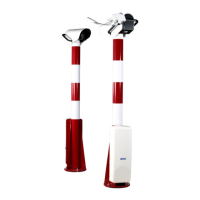User's Guide ______________________________________________________________________
72 __________________________________________________________________ M210667EN-C
NOTE
If LT31 contains a battery backup option and if the unit is stored in an
extremely cold environment, make sure that the battery is fully charged.
Equipment Grounding and Lightning
Protection
The power supply cable with its protective earth conductor (PE) provides
a standard protective ground for the AC power supply inside the interface
unit. A 3-conductor AC cable with a proper earth conductor grounding
must be used.
Equipment grounding protects the electrical modules of LT31 against, for
example, lightning and prevents radio frequency interference. Equipment
grounding for LT31 is done with a jacketed grounding cable and
conductive grounding rod(s). A copper grounding wire with a minimum
cross section of 16 mm
2
, respectively AWG 5, is to be used to connect
the LT31 equipment grounding rod to the local grounding rods.
Depending on the need, one to four copper-sheathed steel rods are driven
into the ground. In case several rods are needed, the alignment from the
foot of the base plate must be radial.
The grounding principles are the following:
- Install the grounding rod as close to the pole mast as possible, to
minimize the length of the grounding cable. The grounding cable can
also be cast inside the concrete base.
- The length of the grounding rod depends on the local ground water
level. The lower end of the grounding rod should continuously touch
moist soil.
The quality of the grounding can be checked with a georesistance meter.
The resistance must be:
- less than 10 to guarantee electrical safety and the intended
functionality of LT31 fuses and overvoltage protection circuitry.
- less than 1 to achieve maximum possible overvoltage protection.
Additionally a ground connection with a minimum cross section of
4 mm
2
, respectively AWG 11 is to be installed between the equipment
grounding of transmitter and receiver unit. This connection ensures that
no potential differences can evolve.
Equipment grounding is shown in Figure 32 on page 73.

